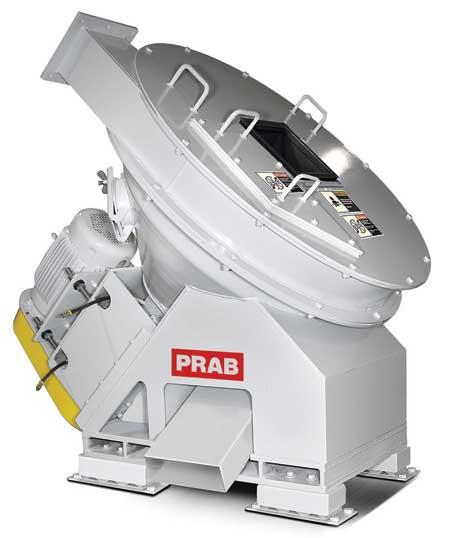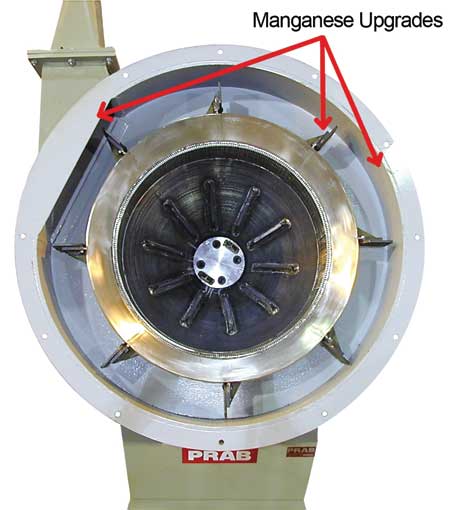
The model 24 AD wringer is for separating cutting fluids from chips. Correctly specifying the wear abrasion's potential of such a unit at purchase can save costs over time.

This cut-away illustrates some of the potential wear points on an air discharge wringer.
The metalworking industry, like many other manufacturing market segments, has been forced to scrutinize capital equipment purchases in an effort to squeeze the most from a tight capital project budget with short expected returns. Often, pre-project planning and equipment evaluation do not take into account the long-term operational effects of rugged operating conditions, faster machining times, material alloys with challenging compositions and varying material quality from global sourcing options.
Wear abatement strategies are especially important when selecting metal scrap handling equipment. Physics and experience dictate where and how a particular part will erode over time. Various wear-resistant materials provide specific advantages but may have drawbacks in other functional areas. Knowing exactly what material the equipment will be running is the key to a durable installation. Up front communication of factory conditions, and concerns and constraints are vital to long-term service life and unplanned downtime.
Critical application data to provide the design engineer for metal scrap handling equipment are:
- The specific alloys to be handled
- Metal chip geometries, densities and abrasiveness expected
- How equipment will be fed (continuous or batch)
- Specific cutting fluids and volume
- Actual normal process rate (lbs./hr.)
- Maximum surge or instantaneous rate (lbs./hr.)
- Frequency and description of bar ends, parts or tramp metal in the chips.
The data provided will give the equipment engineer enough detail to deliver the correct level and placement of wear resistance for the application while deploying realistic, cost-effective recommendations.
As an example, Metal Chip Wringers employ many wear abatement strategies. These units extract cutting fluids from machine shop scrap by exposing the chips to 600 Gs of force at the separation screen. Given today's alloys and production rates, wringer components are subject to severe sliding and impact abrasion, depending on their position in the machine and the characteristics specific to the scrap being processed. To compound the issue, wringer parts need to be formed, cut or machined to produce the unit.
Some specific strategies to protect a Chip Wringer in an extreme wear application:
- Basic unit is designed for replaceable and upgradeable wear surfaces: liner, air paddles, screen, top cover and discharge housing
- Extensive use of AR (abrasion resistant) steels to combat wear such as sliding friction across the formed liner
- Special hard surfacing welding electrodes are used to create a very hard surface applied to specific areas, such as protection of structural welds, impact zones and specific surfaces of the liner and accelerator vanes on harsh applications
- Upgraded wringer screen material adds life to the critical separation area of the unit (Grade 1 screen)
- Manganese steel top cover, discharge housing, air paddles and impact ring work harden to combat the effects of both sliding and impact wear
- For air discharge style wringers Ni-hard castings are used to construct the square to round discharge transition and vibration isolation joint as well as bends for pneumatic discharge piping.
Scrap metal handling equipment requires strategic uses of specialized materials to produce a rugged design. An economic balance between initial cost and durability yields recovery equipment with a low total cost of ownership. Ignoring durability in today's high volume, special alloy environment, usually means loss of production due to unscheduled downtime or replacement of equipment after a long battle to keep it running. When planning the purchase of metal scrap or cutting fluid separation equipment, take into account an application specific wear abatement plan to be sure the investment is sound. Help is available at the earliest stages of a project to be sure the correct equipment is specified to do the job over time.
Authored by Carl Baker, Vice President of Engineering, PRAB Inc.
For more information contact:
PRAB, Inc.
5944 East N Avenue
Kalamazoo, MI 49048
800-968-7722
sales@prab.com
www.prab.com